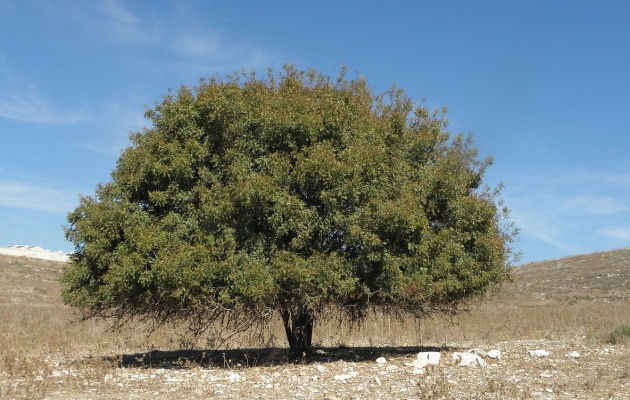The terebinth tree and cultural prostitution
The terebinth, is native to the west Mediterranean, but it has spread eastwards to Greece, Turkey, Syria and Israel, and it is very resistant to drought.
27 MARCH 2022 · 11:00 CET
Cropped.jpg)
They sacrifice on the mountaintops
and burn offerings on the hills,
under oak, poplar and terebinth,
where the shade is pleasant.
Therefore your daughters turn to prostitution
and your daughters-in-law to adultery. (Hosea 4:13)
The terebinth tree (Pistacia terebinthus) is a bush or small tree which normally grows to a height of about 5 metres, although it can reach a height of 10 metres. It is a deciduous tree whose leaves comprise 7 to 9 shiny, oval-shaped, coriaceous leaflets; its yellowish flowers are arranged in clusters and its fruit, the drupe, is a reddish berry, smaller than the pea, which finally turns brown.
The terebinth produces turpentine oil, a resin which, being astringent, was used in the ancient East for medicinal purposes. It was also used to sweeten wine and certain foods. Now it is the basic element in the development of a dissolvent product known as turpentine.
Cropped.jpg)
In the Bible, the Hebrew term that refers to the terebinth tree is the feminine noun elah, which translators often confused with the masculine ellón, meaning “oak”. Therefore the “oak of Moreh” (Deuteronomy 11:30), the “oak at Shechem” (Gen. 35:4), “the oaks of Mamre” (Gen. 18:1) where the Lord appeared to Abraham, were not oak trees but terebinths. [1] In the Septuagint, they are referred to as teréminthos, or terebínthos and in the Vulgate as terebinthus (Hos. 4:13). The terepinth also makes an appearance in the apocryphal book of Ecclesiasticus: Like the terebith tree I have spread my branches as a lovely, exuberant foliage (Ecclesiasticus 24:16).
In ancient times, it was a very well-known tree, venerated by the peoples of the Near East, who celebrated certain sacred rituals under its boughs, such as offerings of incense to the gods or the burial of deceased loved ones or renowned individuals. The Jewish historian Flavius Josephus (37 AD to 100 AD) wrote about a Jewish tradition according to which the Terebinth of Mamre was as old as the world itself. Many legends centred around this tree because both Jews and Pagans, and then Christians after them, offered sacrifices under it, burnt incense or offered up prayers. This tree was said by some to be immune to the fire of the sacrifices. According to historical records, Constantine the Great (302 – 337 AD) tried unsuccessfully to put an end to these sacrifices. The famous Terebinth that Josephus mentioned must not be confused with the modern “oak of Mamre”, the stump of which can still be visited in Hebron, in the Catholic monastery of the Holy Trinity. They are different trees, in different locations.

The terebinth, which belongs to the anacardiáceas family, is native to the west Mediterranean, but it has spread eastwards to Greece, Turkey, Syria and Israel, and it is very resistant to drought. There are known to be some 600 tropical species of the tree, only five of which are found in Israel, and they can live on altitudes of up to 1,500 metres above sea level. Besides the terebinth (Pistacia terebinthus), in the Holy Land there are also the following species of the same genus: the sheep’s tongue (P. atlántica), the Afghanistan Pistacia (P. khinjuk), the mastic (P. lentiscus) and the P. saportae.
The terebinth tree gives off an acrid, resinous or smell, reminiscent of a medical setting, and it can form horn-shaped galls when its leaves are bitten by certain aphids. It appears that these aphids live inside the galls and stimulate the plant’s defence system, which makes it less appetising for herbivores. The trees that grow in areas where livestock graze have been shown to produce more of these galls than specimens growing in other areas.
It is a vigorous, resilient plant, as a result of which it can grow in arid regions where other types of vegetation cannot thrive. It reproduces by its seeds being dispersed by birds, but also by cuttings obtained from it. The terebinth (Pistacia terebinthus) is related to the mastic (Pistacia lentiscus), so much so in fact that hybrids of the two plants can result from them growing close together. These hybrids are very difficult to distinguish from the original plants.
.jpeg)
Photo: Antonio Cruz. The text from Hosea chapter 4 quoted at the start of this article refers to the unfaithfulness of Israel and its priests. Both the people and the leaders had abandoned Yahweh to worship the ignominious god Baal and other Canaanite idols. Wine, grape juice and ritual prostitution, which were central to their religious ceremonies, had overthrown their understanding. They had forsaken the only true God, Creator of the universe, to give themselves over to the idols of stone and clay, which had no more transcendence than the material they were made of. The prophet Hosea accuses Israel’s religious leaders of such spiritual insensitivity that that they were not only condoning but even promoting the spiritual disintegration of the people. Thus spiritual and sexual unfaithfulness are represented as the people’s most serious transgression. Consequently, Yahweh, their jealous and righteous God, would respond to these pagan rituals, which were aimed at seeking the fertility of humans, of their livestock and of the soil, with the curse of barrenness and futility. As verse 10 states: “they will eat, but their hunger will remain; they will fornicate, but fail to reproduce, because they have turned away from the Lord”. When humankind turns their back on the Almighty, sooner or later they reap the consequences.
Notes
[1] Segura, S. & Torres, J., 2009, Historia de las Plantas en el mundo antiguo, CSIC, Deusto, p. 241.
Published in: Evangelical Focus - Zoe - The terebinth tree and cultural prostitution
